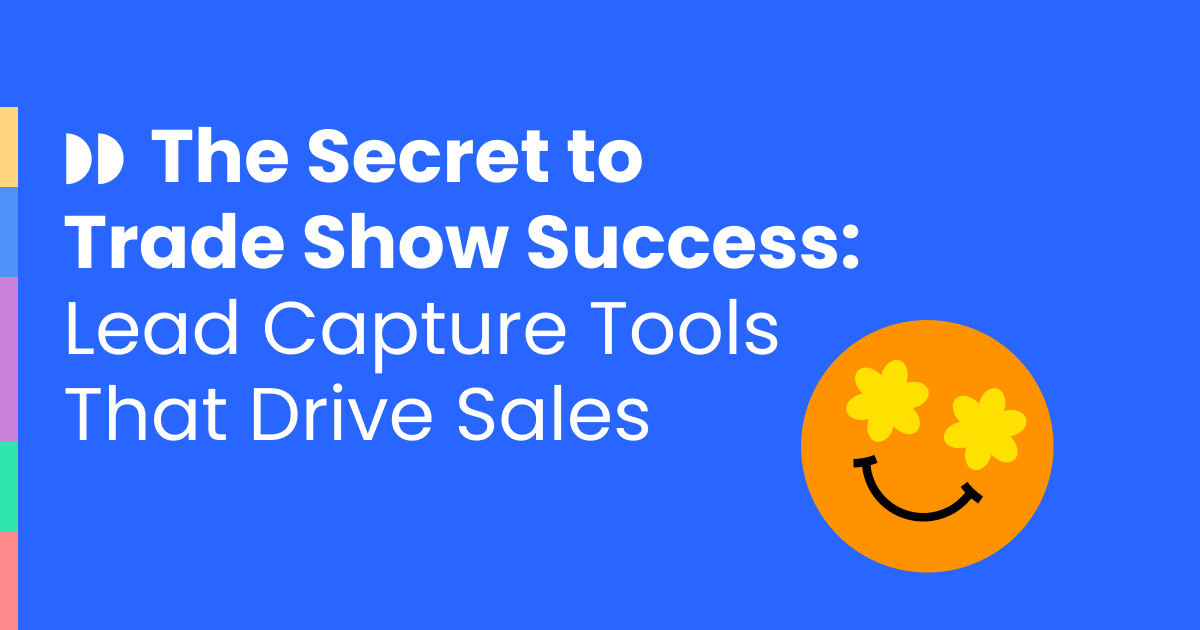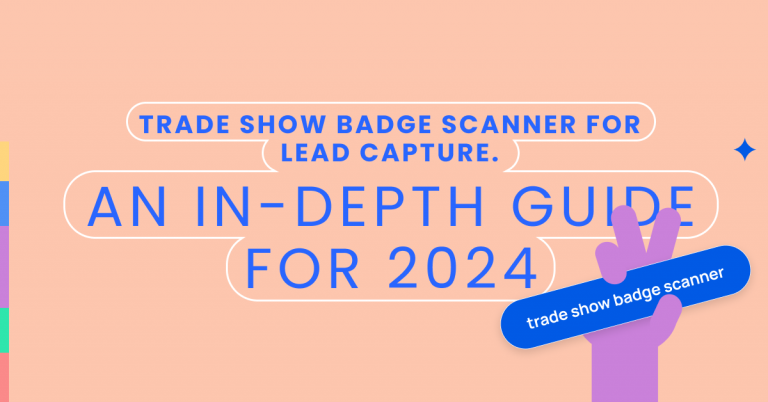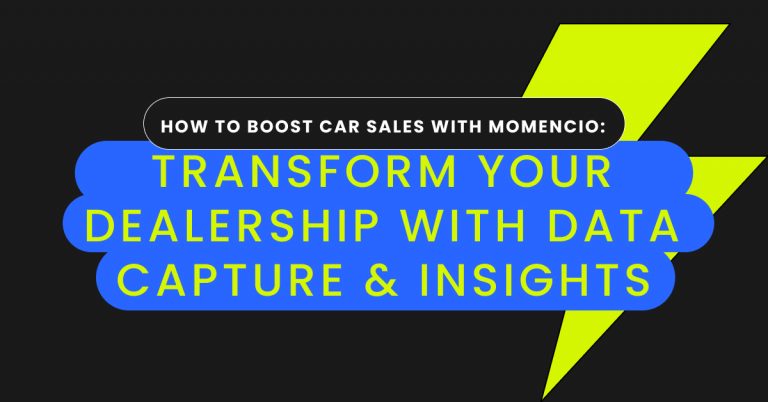The Secret to Trade Show Success: Lead Capture Tools That Drive Sales
Trade shows remain a critical platform for direct business marketing and lead generation. Successful lead management during these events can significantly influence final sales outcomes, making the difference between a good and a great ROI. Recent studies have shown that companies using dedicated lead capture tools report up to a 35% improvement in their sales conversion rates post-event. This introduction delves into the transformative impact of these tools on trade show success and outlines actionable strategies and common pitfalls that businesses often encounter. By leveraging the right tools and tactics, companies can ensure that every lead captured at an event is efficiently nurtured into a successful sale, dramatically enhancing overall sales performance.
Lead Capture Tools That Drive Sales
Understanding Lead Capture Tools
What are Lead Capture Tools?
Lead capture tools are essential technologies used at trade shows and other marketing events to collect information from attendees efficiently. These tools are designed to quickly gather data such as contact details, professional interests, and company affiliations, which are crucial for effective follow-up and lead nurturing. They typically come in various forms, including digital badge scanners, mobile apps, interactive kiosks, and even augmented reality experiences, each serving to enhance the interaction between exhibitors and visitors while seamlessly integrating lead data into sales and marketing systems.
Types of Lead Capture Tools Used at Trade Shows
- Digital Badge Scanners: These devices are the most common lead capture tools found at trade shows. They work by scanning QR codes or barcodes on attendee badges, instantly collecting attendee data and storing it for future marketing efforts.
- Mobile Apps: Custom mobile applications can enable exhibitors to not only capture lead information but also to engage attendees through features such as scheduling meetings, real-time notifications about events, and providing additional company content directly to the user’s smartphone.
- Interactive Kiosks: These stand-alone devices offer interactive experiences for attendees, such as navigating the event agenda, viewing product demos, or entering information manually into contact forms. Interactive kiosks can be strategically placed around the event to maximize attendee engagement and data collection.
- Augmented Reality (AR) Experiences: By integrating AR with lead capture, exhibitors can create unique, memorable interactions that entertain and inform attendees. AR tools can overlay digital information onto the physical booth space, such as detailed product information or interactive stories, which encourage visitors to engage and leave their details in a fun and innovative way.
- NFC and RFID Technology: Near Field Communication (NFC) and Radio Frequency Identification (RFID) are used for more than just payments. At trade shows, these technologies can be embedded into badges or wristbands to allow for seamless data exchange when an attendee engages with a booth or session, providing real-time insights and a smooth, streamlined experience for both parties.
Each of these tools has its strengths and is chosen based on the specific goals of the exhibitor, the nature of the event, and the expected tech-savviness of the attendees. The key to maximizing their effectiveness lies not only in their correct implementation but also in how well they are integrated into the overall event strategy to enhance follow-up actions and lead nurturing processes.
Strategies to Maximize Sales with Lead Capture Tools
Using lead capture tools effectively at trade shows is not just about collecting as much data as possible—it’s about strategically gathering and using that data to drive sales. Here are several methods to ensure that lead capture tools are maximized for sales success:
- Integration with Sales and Marketing Systems
The integration of lead capture tools with existing CRM (Customer Relationship Management) and marketing automation systems is crucial. This allows for the immediate transfer of lead data into the sales pipeline, where sales teams can quickly access it. Seamless integration ensures that data is recovered and noticed and that follow-ups are timely and relevant. For instance, integrating lead data with a marketing automation platform can trigger personalized email campaigns tailored to the specific interests and interactions recorded at the event, thereby enhancing the likelihood of converting prospects into customers.
- Real-time Data Utilization for Immediate Follow-up
Leverage the capability of lead capture tools to use data in real time. This means setting up systems to contact leads immediately after their information is captured—possibly even before the trade show concludes. A quick follow-up, such as a thank-you email or a text message with more information about a product they showed interest in, can significantly increase the chances of a lead moving through the sales funnel. Utilizing real-time responses not only indicates that your business values their interest but also keeps your brand top of mind.
- Personalization of Communication Based on Lead Data
Personalization is critical in converting leads to sales. Use the detailed data captured through lead capture tools to segment your leads according to their interests, behaviors, and preferences noted during the trade show. This data enables more targeted communications that resonate with each lead. For example, if a lead spent considerable time at a demo for a specific product, follow-up communications could include detailed information about that product, customer testimonials, or a special offer to encourage purchase.
- Training Staff on Effective Lead Engagement
Ensure that your staff are well-trained in both the technical use of lead capture tools and the best practices for engaging with trade show attendees. They should be able not only efficiently to capture information but also to make the lead feel valued during the interaction. Staff training should include role-playing scenarios that teach how to open conversations, the importance of active listening, and how to guide the attendee to provide their information willingly and gently.
- Monitoring and Adjusting Strategies in Real Time
Using the analytics provided by lead capture tools, monitor how different strategies are performing in real time and be prepared to make adjustments. For instance, if certain types of follow-up emails are seeing higher open rates and engagements during the event, consider shifting your strategy to capitalize on what’s working best. This agile approach can significantly enhance overall effectiveness and ROI.
By implementing these strategies, businesses can ensure that they not only capture leads more effectively but also move them through the sales funnel more efficiently, ultimately maximizing the return on investment from their trade show participation.
Common Pitfalls in Using Lead Capture Tools
While lead capture tools are invaluable for maximizing trade show success, several common pitfalls can undermine their effectiveness. Understanding these challenges can help organizations avoid costly mistakes and enhance their overall strategy.
- Over-reliance on Technology Without Proper Strategy
Companies need to rely more heavily on technology to do all the work. While lead capture tools can provide sophisticated data collection and integration capabilities, they are not a substitute for a well-thought-out lead management strategy. Businesses must ensure they have a clear plan for how they will use the data collected to nurture leads and convert them into sales. This includes defining clear goals, understanding the customer journey, and having a follow-up plan in place that is responsive to the insights gathered.
- Failure to Train Staff on Lead Capture Tool Usage
Technology is only as good as the people who use it. Adequately training staff on how to use lead capture tools effectively can lead to better data collection practices, such as incomplete data entries, which ultimately affect the quality of leads generated. Training should cover not only the technical aspects of the tools but also best practices for engaging with attendees in a way that encourages them to share their information willingly and thoroughly.
- Lack of Follow-up Post-Trade Show
Collecting leads without a solid follow-up plan is akin to filling a bucket with a hole. Many companies excel at capturing leads during trade shows but then need to engage these leads promptly and effectively after the event. This can result in lost opportunities as potential customers lose interest or forget about the interaction altogether. Organizations need to have automated processes in place for timely follow-ups, such as thank-you emails, personalized offers, or scheduled calls, to keep the momentum going and increase the likelihood of conversion.
- Ignoring Data Quality and Relevance
Another common pitfall is not paying enough attention to the quality and relevance of the data being collected. It’s essential to ensure that the data captured is accurate, up-to-date, and relevant to your sales goals. This means regularly reviewing and cleaning the data, as well as training staff to collect only the information that is truly useful for advancing leads through the sales funnel.
- Not Tailoring the Technology to the Event Audience
Lead capture tools must be appropriate for the audience and the specific nature of the event. For instance, using high-tech solutions like augmented reality might be highly effective at a tech expo but less so at a local trade show where attendees are less tech-savvy. It’s crucial to match the tool to the audience’s expectations and comfort levels to ensure maximum engagement and data collection efficiency.
- Underutilizing Data Collected
Lastly, a significant pitfall is the need for more utilization of the rich data sets collected through lead capture tools. Often, companies collect vast amounts of data but only use a fraction of it for follow-up and lead nurturing. Leveraging this data fully can provide deep insights into customer behavior, preferences, and needs, allowing for more tailored and effective marketing strategies.
By being aware of these pitfalls and actively working to avoid them, companies can significantly enhance the effectiveness of their lead capture strategies and ensure that their trade show investments yield the best possible returns.
Advanced Tips for Trade Show Lead Management
Effective trade show lead management extends beyond simply collecting information—it involves strategic actions that maximize the potential of each lead captured. Here are advanced tips to enhance your trade show lead management practices:
- Leveraging AI and Analytics for Lead Scoring
Incorporating artificial intelligence (AI) and analytics into your lead management process can significantly improve the efficiency and effectiveness of your follow-up strategies. AI can help score leads based on their likelihood to convert, allowing your sales team to prioritize efforts on the most promising contacts. Analytics can provide insights into lead behavior during the event, such as which presentations or products they showed interest in, enabling more personalized follow-up communications.
- Automating Lead Nurturing with Personalized Workflows
Automation can streamline the lead nurturing process, ensuring every potential customer is caught up. Set up automated email workflows that trigger based on specific actions a lead takes, such as downloading a brochure or attending a demo at your booth. Each email should be tailored to reflect the lead’s interests and interactions at the trade show, providing them with relevant information and offers that guide them along the customer journey.
- Enhancing Engagement Through Mobile Apps
Mobile apps can play a crucial role in trade show lead management by facilitating more interactive and engaging experiences for attendees. Apps can offer functionalities like scheduling meetings, real-time event updates, and access to exclusive content. They also provide a direct channel for attendees to provide their feedback and preferences, which can be invaluable for tailoring follow-up actions and measuring the overall success of your event presence.
- Using Social Media for Real-Time Engagement and Follow-Up
Social media platforms can be utilized not just to promote your trade show activities but also to engage with leads in real time. Encourage attendees to connect with your brand on social media and use these platforms to post updates, run live sessions, and continue conversations post-event. Social media interactions can also be tracked and analyzed to gauge lead interest and tailor future marketing efforts.
- Implementing a CRM Integration Strategy
Effective CRM integration is vital for seamless lead management. Ensure that your lead capture tools are fully integrated with your CRM system, allowing for immediate data transfer and access. This integration should support the segmentation of leads according to different criteria, such as interest level, industry, or engagement at the trade show, enabling more focused and effective follow-up strategies.
- Conducting Post-Event Analysis for Continuous Improvement
After the trade show, conduct a thorough analysis of how your lead capture and management strategies performed. Assess which aspects were most successful and identify areas for improvement. This analysis should look at conversion rates, the effectiveness of different engagement strategies, and attendee feedback to refine your approach for future events.
- Personalizing the Attendee Journey Post-Event
Recognize that the relationship with a lead doesn’t end when the trade show does. Continue to engage with them through personalized communications that reflect their specific interests and interactions with your brand during the event. This might include sending customized content, special offers, or invitations to exclusive webinars that can help move them further along the sales funnel.
By implementing these advanced strategies, businesses can transform their approach to trade show lead management, turning brief interactions into lasting relationships and significantly boosting their overall event ROI.
Conclusion
Effectively utilizing lead capture tools at trade shows is more than just about gathering contact details—it’s about strategically engaging with potential clients in ways that foster long-term business relationships and drive sales. By understanding the full capabilities of these tools, implementing best practices, and avoiding common pitfalls, businesses can enhance their trade show success significantly. Advanced strategies like leveraging AI for lead scoring, automating personalized follow-up workflows, and integrating robust CRM systems play critical roles in ensuring that every lead captured is effectively nurtured toward a successful sale.
Furthermore, the adoption of technologies such as mobile apps and social media integration not only streamlines the lead management process but also enhances the engagement and personalization that are crucial for converting leads into customers. Continuous evaluation and refinement of these strategies based on post-event analysis will ensure that businesses remain adaptable and responsive to changing attendee behaviors and preferences.
As trade shows continue to evolve, the need for effective lead capture and management strategies becomes more critical. Embrace the power of advanced lead capture tools to transform your trade show experiences into lucrative business opportunities. Don’t let potential leads slip through the cracks—integrate cutting-edge solutions that ensure every interaction counts.
To discover how you can further enhance your trade show strategies and lead management processes, consider exploring the advanced tools and insights offered by momencio. Our solutions are designed to provide seamless integration, real-time analytics, and personalized engagement strategies that can elevate your trade show success.
Book a demo today to learn more about how momencio can help you maximize your event ROI and turn leads into valuable customer relationships.
FAQs: Top Questions about Using Lead Capture Tools That Drive Sales at Events
- What are lead capture tools?
- Lead capture tools are technologies used at trade shows and other events to collect and store data from attendees. These tools range from digital badge scanners to mobile apps and interactive kiosks, all designed to facilitate efficient and effective lead data collection.
- How do lead capture tools improve sales performance?
- These tools streamline the process of gathering lead information and integrate seamlessly with CRM systems, allowing for rapid follow-up and personalized communication, which are crucial for converting leads into sales.
- What is the best lead capture tool to use at a trade show?
- The best tool depends on your specific needs and the nature of the trade show. However, digital badge scanners and mobile apps are generally very effective due to their ease of use and ability to integrate with other digital marketing tools.
- Can lead capture tools integrate with existing CRM systems?
- Yes, most modern lead capture tools are designed to integrate smoothly with existing CRM systems, ensuring that lead data flows directly into your sales pipeline for immediate action and long-term nurturing.
- What are common mistakes to avoid when using lead capture tools?
- Common mistakes include over-relying on technology without a strategic plan, failing to train staff properly on the tools, neglecting timely follow-up, and not utilizing the full scope of data collected.
- How can I ensure the data collected is of high quality?
- High-quality data collection can be ensured by training staff correctly, setting clear data entry standards, and using tools that verify data at the point of collection.
- What strategies can maximize the effectiveness of lead capture tools?
- To maximize effectiveness, integrate the tools with CRM and marketing automation platforms, use data to personalize follow-ups, and analyze performance data to refine your approach continually.
- How quickly should I follow up with leads collected at a trade show?
- Immediate follow-up — within 24 hours of the event — is ideal. This helps keep your brand at the forefront of attendees’ minds and takes advantage of their fresh interest in your offerings.
- Can lead capture tools help in measuring the ROI of trade show participation?
- Yes, by tracking the lead conversion rate and monitoring the sales generated from these leads, businesses can measure the direct ROI of their participation in trade shows.
- Are there privacy concerns with using lead capture tools?
- Privacy is a significant concern, and it’s crucial to comply with all relevant data protection regulations, such as GDPR. Ensure that your lead capture tools collect data ethically and transparently, with explicit consent from attendees.
Interesting Facts from Research on Lead Capture Tools that Drive Sales at Trade Shows
- High Conversion Rates: Companies using automated lead capture solutions report an average increase of 40% in their lead-to-sale conversion rates compared to manual methods.
- Speed of Follow-Up: A study found that leads followed up within the first 24 hours of a trade show are 60% more likely to convert into sales.
- Data Accuracy: Automated lead capture tools reduce human error in data entry by up to 90%, ensuring more accurate lead information for follow-up campaigns.
- Engagement Levels: Businesses that personalize their follow-up communications based on lead capture data see an 80% increase in attendee engagement post-event.
- ROI Enhancement: Utilizing lead capture tools at trade shows has been shown to increase overall event ROI by as much as 50%, according to recent industry reports.
- Technology Adoption: Over 75% of companies now use some form of digital lead retrieval system at trade shows, a significant increase from just a decade ago.
- Lead Volume: Events that employ interactive lead capture tools like gamification or AR experiences capture up to 30% more leads than events that do not.
- User Preferences: 65% of trade show attendees prefer providing their information through digital means rather than traditional paper forms.
- Market Trends: The demand for lead capture tools is projected to grow by 20% annually over the next five years as companies continue to recognize their value in the sales process.
- Sustainability Impact: Digital lead capture solutions contribute to sustainability efforts by reducing the need for paper, with many companies highlighting this as part of their green policies.

















































